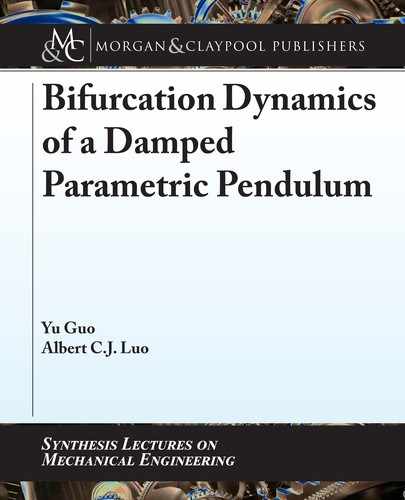4.5. PERIOD-5 AND PERIOD-6 MOTIONS TO CHAOS 27
2:1696, another saddle-node bifurcation occurs, where the symmetric period-4 motions
switches from stable to unstable, and asymmetric period-4 motions are introduced. Again, such
asymmetric period-4 motions are not illustrated herein. On the third bifurcation tree, the in-
dependent symmetric period-4 motion is stable for 2 .2:2013; 2:2543/, which overlay with
part of the second bifurcation tree. At 2:2543, a saddle-node bifurcation is for the onset
of symmetric period-4 motion with a stable to unstable switching. At 2:2013, the saddle-
node bifurcation introduces asymmetric period-4 motions while the symmetric period-4 mo-
tions become unstable. A more detailed presentation is provided through the zoomed view for
2 .2:0; 3:0/ in Figs. 4.5c,d. e aforementioned three bifurcation trees of period-4 motions
to chaos are non-travelable. However, the fourth branch of asymmetric period-4 motions to
chaos is travelable for 2 .0:0;5:8029/. e onset of such asymmetric period-4 motions occurs
at 5:8029, and the stable asymmetric period-4 motions exist for 2 .5:5327; 5:8029/. At
5:5237, the period-doubling bifurcation of the asymmetric period-4 motion occurs for the
asymmetric period-8 motion, which will not be presented herein.
4.5 PERIOD-5 AND PERIOD-6 MOTIONS TO CHAOS
e bifurcation trees for travelable asymmetric period-5 motions to chaos are presented in
Figs. 4.6a,b for 2 .2:0; 6:5/. ere are two bifurcation trees of period-5 motions to chaos. e
paired period-5 motions are asymmetric. On the first bifurcation tree, the asymmetric period-5
motion is stable for 2 .6:0804; 6:1537/. e onset of such asymmetric period-5 motions is at
the saddle-node bifurcation of 6:1537. At 6:0804, period-doubling bifurcation of the
asymmetric period-5 motion introduces period-10, period-20… motions which are not illus-
trated due to the tiny stable ranges. On the second bifurcation tree, the asymmetric period-5
motions exist for 2 .3:9425; 3:9625/. e saddle-node bifurcation of 3:9625 is for the
onset of the asymmetric period-5 motion. At 3:9425, the cascaded period-doubling bifur-
cation of the asymmetric period-5 motion introduces period-10, period-20… motions eventu-
ally to chaos.
e tree bifurcation trees for independent period-6 motions are presented in Figs. 4.6c,d
for 2 .3:2; 4:4/. Such period-6 motions are independent, which are not born from period-
doubling bifurcations of period-3 motions. Two kinds of bifurcation trees of period-6 motion to
chaos are observed. e first kind of bifurcation tree is from symmetric to asymmetric period-6
motions and to chaos, which is non-travelable. e second kind of bifurcation tree is directly
from an asymmetric period-6 motion to chaos, which is travelable. ere is only one bifurca-
tion tree for independent asymmetric period-6 motions to chaos. Such an asymmetric period-
6 motion is stable for 2 .3:7261; 3:7363/, which are neither from saddle-node bifurcations
of symmetric period-6 motion, nor from period-doubling bifurcations of asymmetric period-3
motions. Instead, such a bifurcation tree of the asymmetric period-6 motion to chaos exist in-
dependently. At 3:7363, saddle-node bifurcation is for onset of the asymmetric period-6
motion. At 3:7261, such an asymmetric period-6 motion is from stable to unstable through

28 4. BIFURCATION TREES
(a) (b)
Ω
Ω
π
π
π
π
π
(c) (d)
Ω
Ω
π
π
π
π
π
Figure 4.6: Period-5 motions to chaos with 2 .2:0; 6:5/: (a) node displacement x
mod.k;N /
,
(b) node velocity y
mod.k;N /
. Period-6 motions to chaos with 2 .3:2; 4:4/: (c) node displace-
ment x
mod.k;N /
, (d) node velocity y
mod.k;N /
. (˛ D 4:0, ı D 0:1, Q
0
D 5:0.)
the period-doubling bifurcation, which further introduces period-12, period-24… motions to
chaos.
Two bifurcation trees for non-travelable symmetric period-6 motions are observed. e
first one has a stable range of 2 .4:1857; 4 :2197/ . e onset of such symmetric period-6
motion occurs at a saddle-node bifurcation of 4:2197. e saddle-node bifurcation at
4:1857 is for onset of asymmetric period-6 motion from the symmetric period-6 mo-
tion. e introduced asymmetric period-6 motions are not illustrated due to the very tiny
stable ranges. e second branch of the symmetric period-6 motion is stable for the range
2 .3:9155; 3:9443/. At 3:9443, a saddle-node bifurcation is for the onset of the sym-
metric period-6 motion. At 3:9155, a saddle-node bifurcation is for a pair of asymmetric
period-6 motions from the symmetric period-6 motions. Such asymmetric motions are stable
..................Content has been hidden....................
You can't read the all page of ebook, please click here login for view all page.
